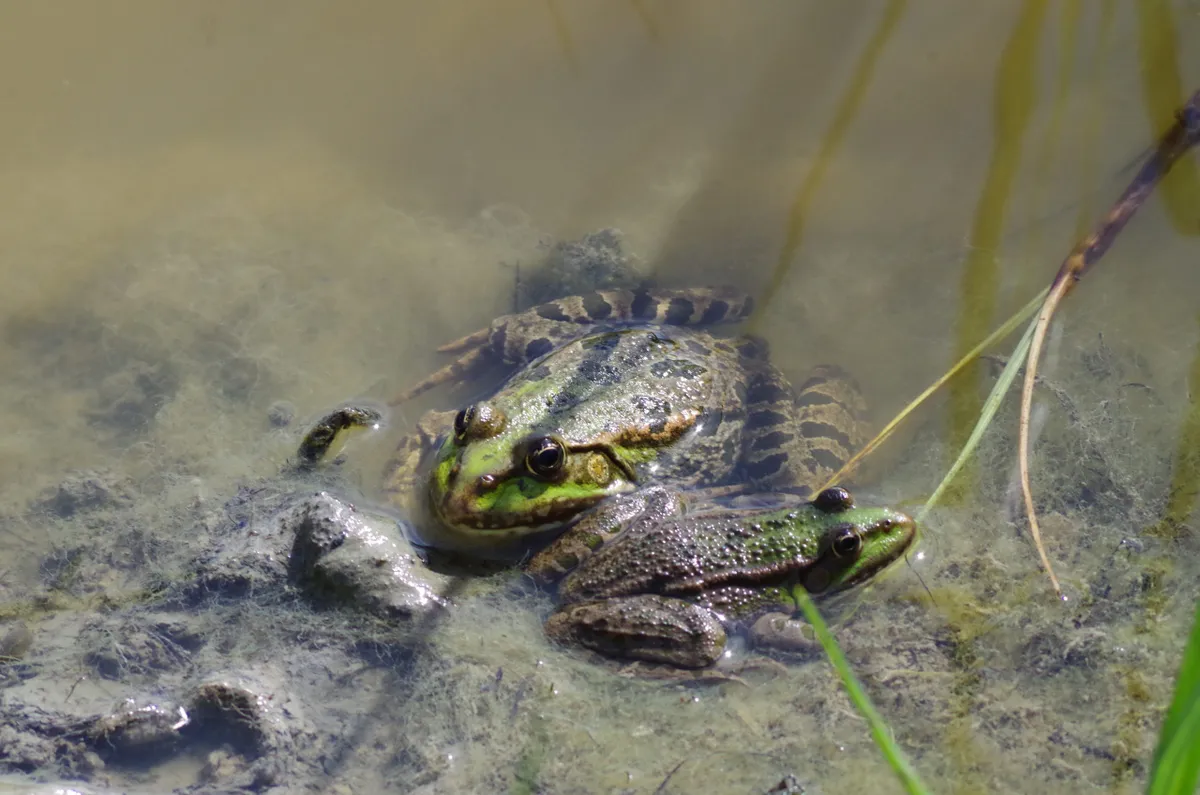The marsh frog is a non-native species in the UK, introduced to Kent in the 1930s. Here is our expert guide by zoologist and PhD researcher Steve Allain:
What is a marsh frog?
Marsh frogs (Pelophylax ridibundus) are Europe’s largest native frog species, however they are not native to the UK. They were introduced to the UK during the last century.
As their name suggests, they prefer marsh habitats and are resilient to brackish water making them suitably adapted for salt marshes. They’re also highly adaptable and bask in the sun, so may be seen along agricultural irrigation ditches or other similar linear features.
What do marsh frogs look like?
They vary in colour, but generally tend to be green or brown with two dorsolateral folds running from behind their eyes down their backs.

However they also look very similar to both introduced and native populations of the pool frog (Pelophylax lessonae) and introduced edible frog (Pelophylax esculentus).
Marsh frogs can reach a maximum snout-to-vent length of 17 centimetres, but most individuals are smaller than this. Once of the first things you’ll notice in marsh frogs is that their head is proportionally large, which makes them voracious predators.
Where are marsh frogs native to?
The marsh frog occurs throughout a large part of Europe and Western Asia from France to Iran and Kazakhstan. It is likely however that some of the marsh frogs across this distribution represent currently unknown species of marsh frogs.
Where did the marsh frogs come from?
The first intentional introduction occurred at Romney Marsh in Kent in the in the mid-1930s from Eastern Europe. Since then a number of other introductions have taken place from across their native range which has helped contribute to their spread and colonisation of the UK.
Research is needed to determine exactly where all of the populations came from but perhaps marsh frogs from across their range can be found in the UK.

Where can marsh frogs be found?
Marsh frogs are now predominantly found in south-east England, having expanded from their original introduction site in Kent to the surrounding counties.
Other populations can be found in Essex, Norfolk, Devon, Bristol, Cornwall and the Isle of Wight, as well as elsewhere in the UK.
Please note that external videos may contain ads:
Marsh frog underwater. © Jack Perks Photography
What do marsh frogs sound like?
Marsh frogs have a very distinct call compared with our native amphibians, which sounds like laughter. Males produce this call from two vocal sacs on either side of their mouths that help to amplify the sound.
With the use of these vocal sacs, their call can carry for hundreds of metres across marshes to attract mates or warn rivals of their presence.
What threats do marsh frogs post to our native amphibians?
The impacts of marsh frogs are not currently known but likely include predation of native species as well as acting as a disease vector. Most known populations have been found to be expanding their range which means they are increasingly likely to come into contact with vulnerable native species.
Marsh frogs have previously tested positive for the amphibian chytrid fungus (Batrachochytrium dendrobatidis) which has been implemented in the decline and extinction of amphibians globally.
Marsh frogs can be also be significant prey items for barred grass snakes (Natrix helvetica) with their large size and basking behaviour making them perfect targets for the snakes.
How are marsh frogs endangered?
With such a wide range the marsh frog is listed as Least Concern by the IUCN Red List.
Can marsh frogs hybridise with other species?
Water frogs (including the marsh frog) can produce fertile hybrids via a process known as hybridogenesis. An example of this is the edible frog which is a hybridogenetic hybrid of the marsh frog and the pool frog.
Strangely enough edible frogs produce gametes of marsh frogs and so can breed with marsh frogs to produce more marsh frogs. If they however breed with pool frogs then they produce more edible frogs.
Steven Allain is an avid herpetologist, photographer, researcher and science communicator. His research covers a range of topics, which most recently has involved investigating the population dynamics of grass snakes and the effects of ophidiomycosis.
One of his main missions outside of his research is to communicate the growing need for interest in the conservation of amphibians and reptiles.
Steven also helps to engage members of the public through a number of different means such as via social media and podcasts, to answer their questions about amphibians and reptiles, whilst also reiterating whilst these two groups of animals are vital components of a healthy ecosystem.
Main image: Marsh frog. © Steve Allain
